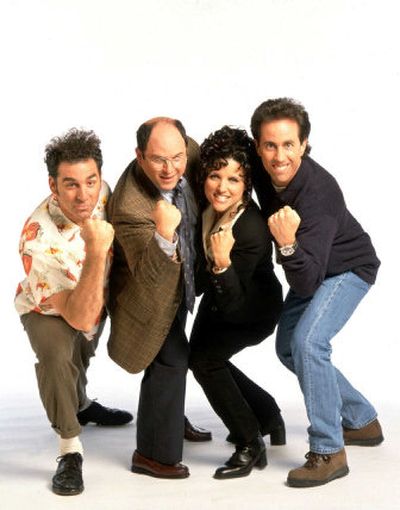Masters of their domain

“Seinfeld” has not suffered from shrinkage.
Seven years after its finale, not only does the classic sitcom air up to two hours a day in some markets, but the reruns remain fresh enough to spark watercooler chitchat about everything from puffy shirts to mimbos.
“Isn’t it weird how present it still is on the television landscape?” Jerry Seinfeld wondered during a recent joint interview with Jason Alexander (who played George), Julia Louis-Dreyfus (Elaine) and Michael Richards (Kramer).
“I hear it all the time: ‘We go to bed with you guys. We never miss it,’ ” says Alexander.
Tuesday marked the DVD release of seasons five and six, a period when “Seinfeld” was at its peak with episodes like “The Fusilli Jerry,” “The Face Painter” and “The Opposite.”
“Most people, you do a TV series, it ends three, four, five years later; it’s a relic,” Seinfeld says. “But we’re still hearing from the people, the audience, the people on the street, as if we’re still doing it.
“It feels alive.”
Seeing the four principals together again is like a reunion of the Beatles – for the actors as well, who are rarely together any more. Despite last year’s acrimony over DVD proceeds, today they revel in each other’s company, quickly recounting dialogue when certain scenes are mentioned.
Recalling Kramer’s exploits to save a severed pinky toe by commandeering a city bus, Alexander repeats Jerry’s line: “You kept makin’ all the stops?”
“They kept ringing the bell!” Richards replies, in character.
And they all laugh – it’s still funny to them.
Similarly, on many of the DVD commentaries, insider insight devolves into simple laughter; the viewer no longer has a guide, but a companion on the couch.
“The show had an intense comedic energy that you do not find on other shows,” Seinfeld says. “There’s an intense comedic scene happening all the time, and that’s the way we tried to make them, really packed, tight, strong – and that just holds the audience.”
Alexander adds, “On this show, the comedy was the thing, so if you had to kind of trash a character a little bit…”
“Or entirely,” chimes Louis-Dreyfus, whose character perhaps suffered the most – a long, subtle descent from “sponge-worthy” to flirting with Newman, if needed.
“Seinfeld” nearly didn’t get the chance to become a hit. It wasn’t until the third or fourth season that the show really found its rhythm and audience.
“It seemed early on that it was such a specific audience and when every new element of the audience came on, I was just thinking, ‘Wow,’ ” Alexander says.
He remembers being astounded when he saw, through his mother’s friends, “the senior citizen community groovin’ on our show.”
Says Seinfeld: “It really was written and geared for a very specific audience, but our comedic strength trumps all of that. The subject matter, the dialogue, the tone isn’t right for most of America.”
Part of what he’s referring to is the racy material. Though vulgarity is often hidden by acrobatic metaphors and pregnant omissions (“You know, I was alone…”), “Seinfeld” still managed to slide plenty past the censors.
How did they get away with their most heralded triumph, “The Contest,” from season four?
“We were somewhat unsupervised,” Seinfeld says. “The audience was there and the network is not going to complain if everyone’s liking the show.”
But one fact of television life is that it can’t help but eventually feel dated. While “I Love Lucy,” “M*A*S*H” and “Cheers” still have their charms, they are very much of their era.
The absence of cell phones, Jerry’s old computer and the group’s fondness for “Melrose Place” may soon feel antiquated. Louis-Dreyfus cringes at some of her outfits and hairstyles, and is quick to correct Seinfeld’s claim that her clothes have aged more than his.
After the show ended, Seinfeld, 51, mostly went back to stand-up, a journey chronicled in the documentary “Comedian.”
The other three have tried new shows: Alexander with last season’s canceled “Listen Up,” Richards with the failed “The Michael Richards Show,” and Louis-Dreyfus on “Old Christine,” which debuts at midseason on CBS.
But being pigeonholed by “Seinfeld” is a price the cast will gladly pay.
“What actor wouldn’t want that kind of experience?” says Louis-Dreyfus, 44.
Perhaps inevitably, the foursome is further removed from “Seinfeld” than many fans. Richards, 56, says he never says Kramer’s catchphrase, “Giddy up!” – “not even when I’m on a horse.”
They say they rarely watch their old show, though Alexander, 46, recounts the fun of watching “Seinfeld” with his children, who were surprised what a jerk their father was.
The cast will nevertheless have plenty to remind them of “Seinfeld.” People actually practice Mr. Constanza’s pseudo Christmas holiday, Festivus, for example.
Alexander still gets shouts of “Can’t-stand-ya” and “these pretzels are makin’ me thirsty!” Louis-Dreyfus hears “yada yada yada,” and Seinfeld is asked “where’s Kramer?”
So what does Richards get?
“Wish you were back,” he says.